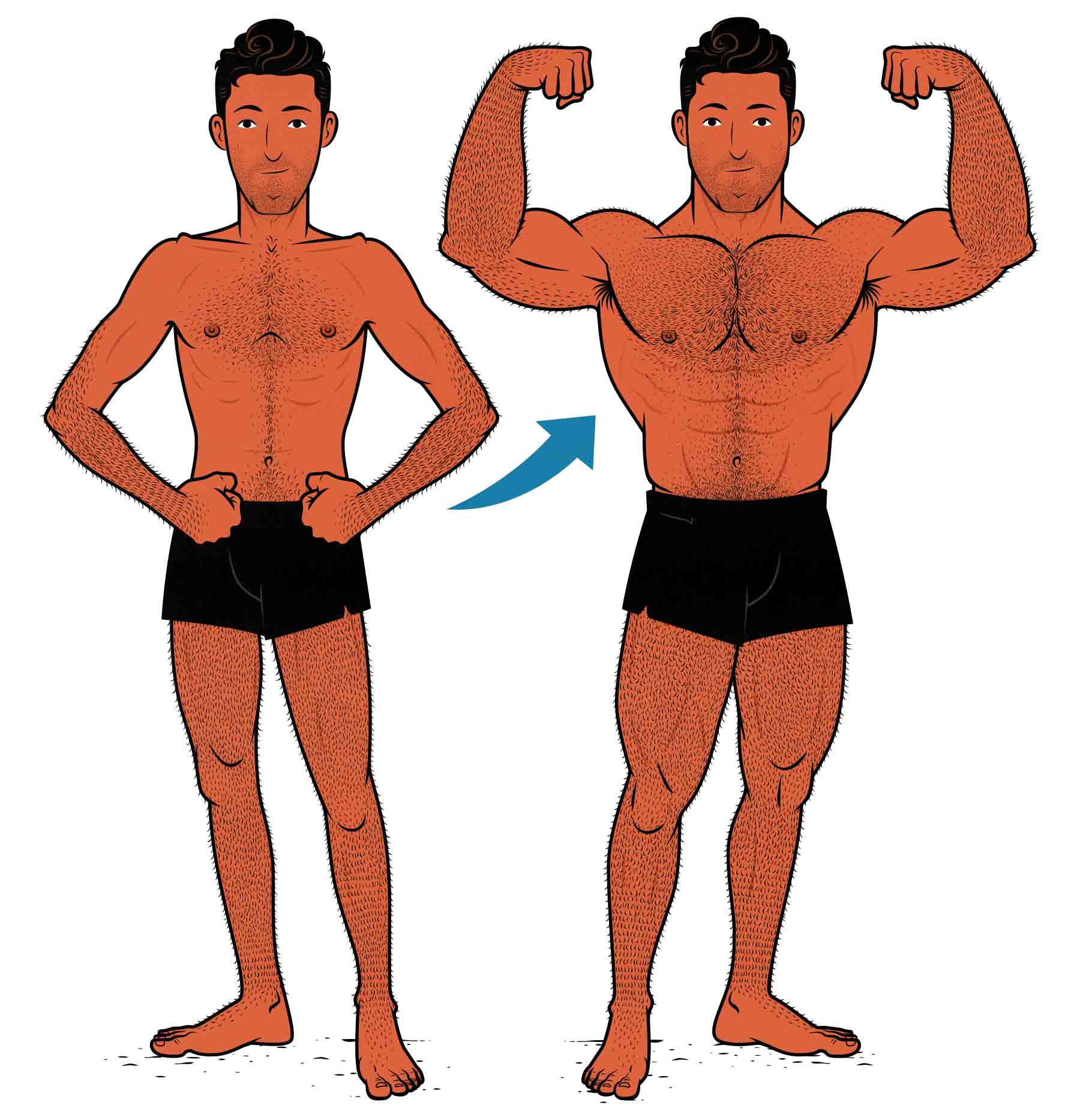
How Accurate Are DEXA Scans? What About BIA Scales? InBody?
I had a horrible experience with a BIA scale when I first started bulking. I’ll tell you the story in a second. That made me curious, so I delved deeper into it, trying to figure out what had gone so terribly wrong.
That bulk was 15 years ago, and I started writing about the inaccuracies of BIA scales eight years ago.
Now, there’s a new trend of fitness influencers tracking their body fat percentage with DEXA scans. Jeff Nippard are Jeremy Ethier are the most famous examples. They’re using the scans to track their progress more objectively. I get the appeal of that, but DEXA isn’t very good at tracking changes in body composition.
Tracking your body composition with BIA scales or DEXA scans is usually a mistake.

You Should Track Your Progress
Most people make the mistake of focusing on effort rather than on outcome. Maybe you ask someone for advice, and they give you a dismissive answer like, “Just lift hard,” or “just eat more,” or “just eat clean.” Maybe they tell you all this tracking stuff is just a bunch of overcomplicated nonsense.
“Why do you need to track your strength if you’re pushing hard on every set? Taking a set to failure is guaranteed to stimulate muscle growth.”
“You don’t need a spreadsheet. You just need vigour.”
But that’s backwards. The goal isn’t to push harder, it’s to get bigger, stronger, leaner, fitter, healthier, and better-looking:

Pushing hard is important, but it’s just one of several factors that can help you accomplish the goals you actually care about. And there’s no guarantee that pushing hard will be enough.
Imagine a guy who loads 185 onto the barbell every time he benches, and he pours his full spirit into it, getting 4–6 reps before hitting all-out failure. Maybe he even borrows some vigour from his training partner, allowing him to get a couple of cheat reps in.
His effort is admirable, but it isn’t adding up to progress. We know this because he isn’t getting stronger. He’s always loading 185 pounds onto the bar, always failing before 7 reps. If he were building muscle, those bigger muscles would be able to move more weight.
You can spend decades this way. Most people do. Most guys never load two plates onto the barbell. Worse, some people never even realize it isn’t working. They get stuck at the early intermediate level for their entire lives.
It’s even worse for beginners. If you don’t know if you’re making progress, it’s almost impossible to keep your motivation high enough to keep going. Most beginners fall off the wagon after a few months, unsure whether their efforts have given them much of anything at all.
Body Fat Is Hard to Measure Accurately
The desire to objectively track your progress is a good one. That’s a great type of energy to have. Funnelling your nerdiest energy into transforming your body works incredibly well. My nerdiest bulks have been my best bulks, by far.
We got a negative review once, and I still think about it sometimes. The person said The Bony to Beastly Program was great, but the coaching community had the energy of a bunch of computer programmers.
That criticism stuck with me because he wasn’t wrong. Before starting Bony to Beastly, Jared and I made our living designing and coding websites for musicians. We definitely lean nerdier, and I think it’s why we’re able to get people such consistently great results:
- Most of our members like to write things down.
- We’re the sorts of coaches who look at what people write down.
But most of us track our body composition the wrong way. And I get where the confusion comes from. I made the same mistake.
Body Composition Scales & Scans
Personal DEXA scans are the new bodybuilding trend. If you watch a video about building muscle or burning fat, you’ll probably see someone like Jeff Nippard or Jeremy Ethier getting DEXA scans to measure their body composition. That can make it seem like DEXA scans are a good way to track your progress.

If you sign up for a gym membership, you might get talked into a free consultation with a personal trainer. That personal trainer will probably have you hop on an InBody scanner, which will give you an impressively detailed (but misleading) overview of your body composition.
When you buy a bathroom scale, you’ll probably notice that the most expensive ones with the best reviews have fancy BIA scanners that can estimate your body fat percentage. And that brings us to the problem.
The Horror of BIA Scales
On the left, I weighed 150 pounds, and my fancy new bioelectrical impedance analysis (BIA) bathroom scale pegged me at 12% body fat, which seemed plausible:

Three months later, on the right, my BIA scale told me I weighed 175 pounds and had 20% body fat. If true, that would mean I’d gained 8 pounds of muscle and 17 pounds of fat.
It wasn’t a fluke reading. I had been weighing myself every week, watching my body fat percentage climb ever higher. It had been weighing heavy on me. I thought my bulk was going horribly.
By the end of the bulk, I was thrilled with how I looked, but 20% is at the upper limit of the healthy body fat range, so I figured I should cut:

I spent four weeks cutting pretty aggressively, thinking I had a ton of fat to lose. To my surprise, after losing just a few pounds, I was clearly leaner than when I started, but my scale still said I was at 18% body fat.
I was confused, so I searched around for an answer. I discovered my BIA scale had an “Athlete Mode” for people with more muscle than average. After three months of bulking, I now had ever-so-slightly more muscle than average, so I turned on Athlete Mode, and I got a reading of 9% body fat.
That was a relief. My bulk had been a disaster, but my cut had gone much better than expected! I had gained 12 pounds of muscle and lost 20 pounds of fat in 4 weeks.
Just to be clear, neither the Default Mode nor the Athlete Mode is “correct.” The scale needs to know how muscular you are before it can guess how fat you are. If you gain 20 pounds of muscle while losing 20 pounds of fat, your BIA scale won’t know what has happened. It won’t automatically switch you over to Athlete Mode.
I know this sounds ridiculous, but BIA scales don’t really understand the difference between these two photos:

If this sounds implausible, you can run a simple test. Step on your scale, get your body fat estimation, drink a litre of water, and then do it again. You haven’t gained any fat—water is 100% lean—but I bet the scale will think you’re fatter.
BIA is kind of like BMI. It’s a little bit better, but not by very much (study, study, study). The main things it’s looking at are height and weight, so if you’re gaining weight, it will assume you’re getting fatter. That’s reasonably fair for the average person who’s accidentally overeating, but it’s not useful for someone who’s lifting weights and bulking up.
If you have a BIA scale, I would turn it off or ignore it. It isn’t accurate enough to be useful, and the noise can be confusing. Better to use your scale to measure your body weight, not to estimate your body fat percentage.
How Accurate Are DEXA Scans?
Getting a DEXA scan seems like a research-grade, objective way to measure your body composition, but that isn’t what it does. It isn’t like measuring the circumference of your biceps or weighing yourself. Those are actual measurements. DEXA is just giving you an estimate, and that estimate has a fairly large margin of error.
DEXA is the best body composition estimation tool available to regular people, but it’s common for it to be off by about 4–5% in either direction (study, study). If you’re at 15% body fat, you’ll probably get a scan showing 10–20% body fat. In rarer cases, it can be off by as much as 10%.
For example, as with BIA scales, small changes in hydration can throw off its estimates (study). If you eat more salt, drink more water, or pee at a different time, it can throw off the estimate. Same thing if you’re at a different point in your bulk or cut, or worse, trying to compare the end of a bulk to the end of a cut—more on that in a second. You can solve some of that by getting the DEXA scan under very similar circumstances, but it won’t be perfect.
DEXA works quite well in research. If all of the participants are at 15% body fat, some will get readings of 10% and a similar number will get readings of 20%. If you have enough participants, it will average out to 15%. If that average body fat percentage drops from 15% to 13% after a few months of training, you can make a good argument that the workouts improved body composition.
It’s pretty bad for tracking your own progress, though (study, study). For example, as James Krieger explains here, in this study, the most accurate method (a four-compartment model) estimated that a participant gained 5% body fat. DEXA estimated that he’d lost 5% body fat.

Here’s a DEXA scan showing me at 11% body fat. That’s probably about right. But I got lucky. I was lean enough to confirm the findings in the mirror. In a situation like this, where you can double-check the findings, DEXA isn’t very risky (or useful).
DEXA is a nightmare for tracking your progress. Let’s say you’re starting your bulk at 15% body fat, but you don’t know you’re at 15% body fat, so you get a DEXA scan. Let’s say the DEXA scan falls within the typical margin of error and gives you a reading of 11% body fat, which seems about right. So far, so good.
Now let’s imagine that you spend 6 months bulking, and you gain 10 pounds, and your body fat percentage stays the same—still 15%—but you don’t know that, so you get another scan. The reading is within the same margin of error, this time giving you a reading of 19% body fat.
In reality, your bulk went great. You’re still at 15% body fat. That means only 15% of your gains were fat. You’ve gained 1.5 pounds of fat and 8.5 pounds of muscle. But the DEXA scan says you’ve gained 14 pounds of fat and lost 4 pounds of muscle. That sounds extreme, but it’s fairly common (study).
Bulking & Cutting Mess With Body Fat Estimations
I’ve been talking about muscle and fat, but body composition scales and scans aren’t estimating muscle mass; they’re estimating lean mass: bone mass, hydration, gut contents, contractile muscle tissue, glycogen, etc.
- Bulking Inflates Lean Mass: Even if the estimations of lean mass were perfectly accurate, you’d expect to gain a bunch of extra lean mass while bulking. Your gut will have extra food in it. Your muscles will be pumped full of extra glycogen (water and sugar). That can inflate your results while bulking.
- Cutting Deflates Lean Mass: You’d also expect to lose a bunch of lean mass while cutting. You’re eating less food, so there’s less of it in your gut. Your muscles will deflate, too, losing some of their glycogen. Even if you don’t lose an ounce of contractile tissue, you may very well lose a few pounds of lean mass. That can be heartbreaking.
So, if you’re tracking your body composition changes, you’d want to compare the results of your bulk with the results of your next bulk. Bulk, cut, bulk again, and then estimate your body fat percentage. By that point, maybe a year has gone by. That might be enough time for your results to exceed the margin of error, especially if you’re a beginner.
If you’re staying at about the same weight, trying to get body recomposition, then you aren’t confusing the BIA and DEXA scans with differing gut contents and muscle glycogen. However, your body composition changes would need to be quite dramatic to cut through the noise. And so again, you’d want to take the measurements at least a year apart.
How to Track Your Progress (TBC)
It’s absolutely crucial that you track your progress. It’s by far the most important part of a transformation. But BIA scans are so inaccurate that I’d call the readings outright misinformation. I would treat that feature like an enemy trying to trick you.
DEXA is the best body composition estimation tool you have access to, and it isn’t even close to being good enough to be useful. Not even Jeff Nippard’s $4,000,000 Muscle Lab, complete with a personal DEXA scanner, operated by a famous exercise scientist, is fancy enough to track your progress.
That can seem like a problem. It isn’t, though. Most bodybuilding coaches aren’t scanning their clients, even though their careers hinge on their body composition. When Marco was helping professional and Olympic athletes bulk up, he wasn’t giving them DEXA scans, even though it would have been well within their budget. There are better ways.

We use a super cheap and simple system with people doing our muscle-building programs. You can do it at home. It only costs a few dollars. People have been doing it for decades. And it works dramatically better. I’ll explain it in the next article.
To be continued…

In the meantime, if you want our help building muscle, check out our Bony to Beastly Program. It comes with a full six-month workout program, a diet guide, a recipe book, tutorial videos for every exercise, and online coaching from us.
Shane Duquette is the founder of Outlift, Bony to Beastly, and Bony to Bombshell, each with millions of readers. He's a Certified Conditioning Coach (CCC), has gained 70 pounds, and has over a decade of experience helping more than 15,000 people build muscle. He also has a degree in fine arts, but those are inversely correlated with muscle growth.

Muscle-Building Mini-Course via Email
Sign up for our 5-part muscle-building mini-course that covers everything you need to know about:
Here are some related articles